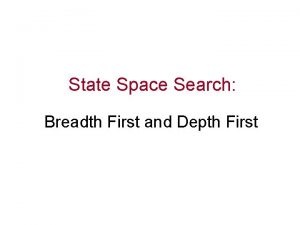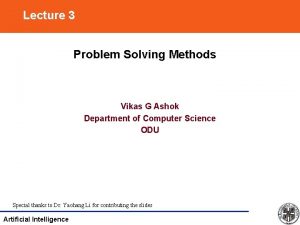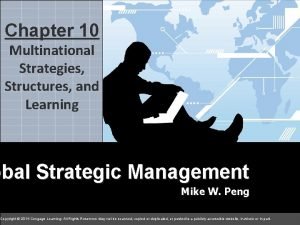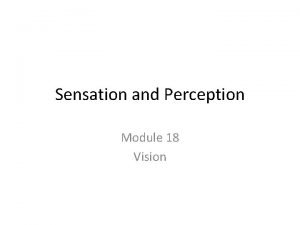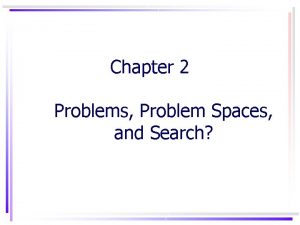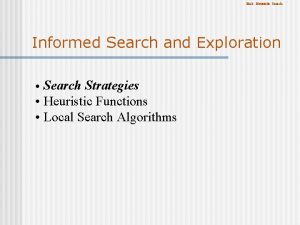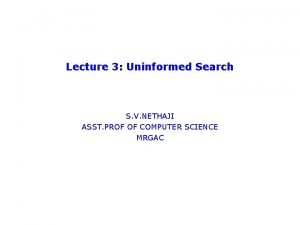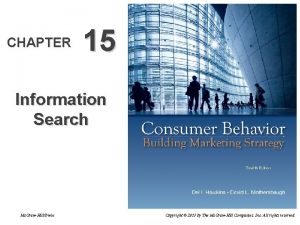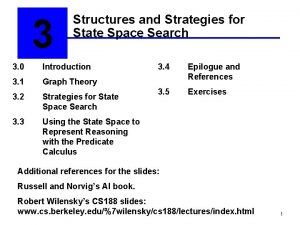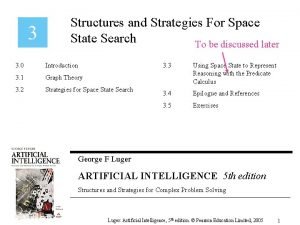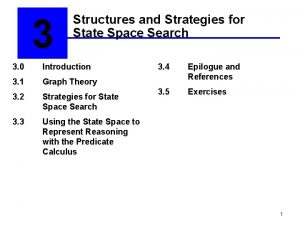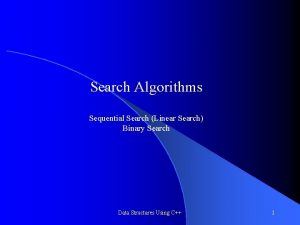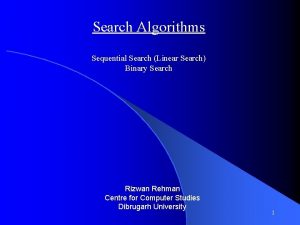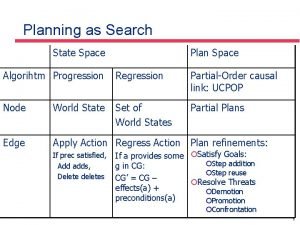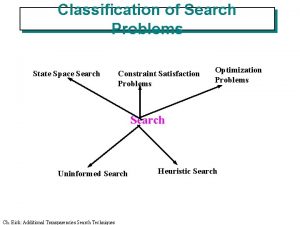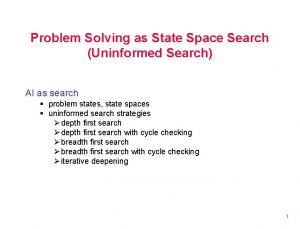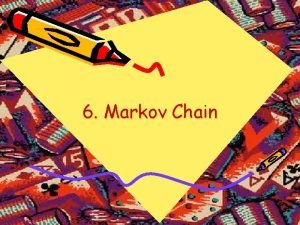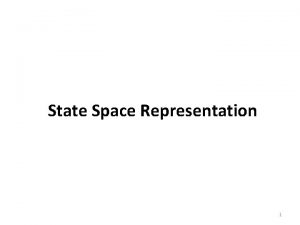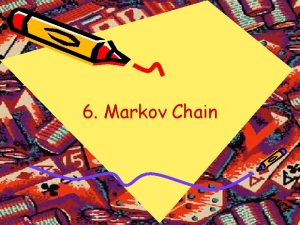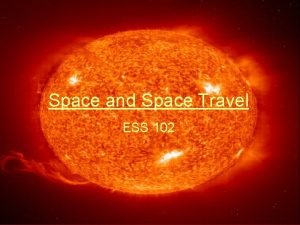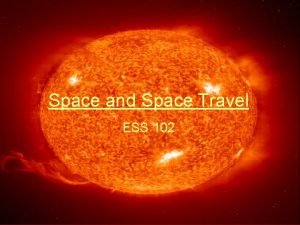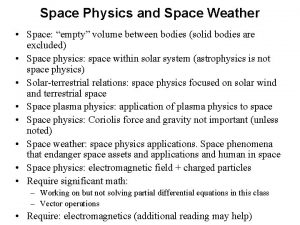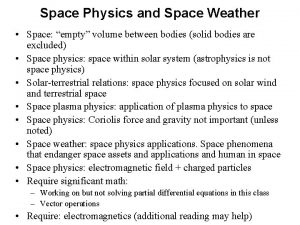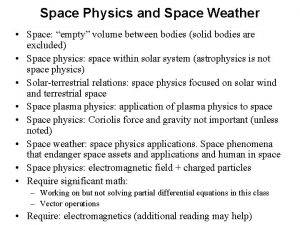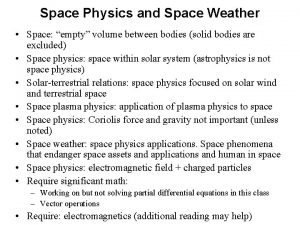3 Structures and Strategies for State Space Search















![State space search Represented by a four-tuple [N, A, S, GD], where: • N State space search Represented by a four-tuple [N, A, S, GD], where: • N](https://slidetodoc.com/presentation_image_h/af667aba58c5d1aa90ad540be1fe4495/image-16.jpg)







































- Slides: 55

3 Structures and Strategies for State Space Search 3. 0 Introduction 3. 1 Graph Theory 3. 2 Strategies for State Space Search 3. 3 Using the State Space to Represent Reasoning with the Predicate Calculus 3. 4 Epilogue and References 3. 5 Exercises Additional references for the slides: Russell and Norvig’s AI book. Robert Wilensky’s CS 188 slides: www. cs. berkeley. edu/~wilensky/cs 188/lectures/index. html 1

Chapter Objectives • Learn the basics of state space representation • Learn the basics of search in state space • The agent model: Has a problem, searches for a solution. 2

Graph theory: The city of Königsberg The city is divided by a river. There are two islands at the river. The first island is connected by two bridges to both riverbanks and is also connected by a bridge to the other island. The second island two bridges each connecting to one riverbank. Question: Is there a walk around the city that crosses each bridge exactly once? Swiss mathematician Leonhard Euler invented graph theory to solve this problem. 3

The city of Königsberg 4

Graph of the Königsberg bridge system 5

Definition of a graph A graph consists of • A set of nodes (can be infinite) • A set of arcs that connect pairs of nodes. An arc is an ordered pair, e. g. , (i 1, rb 1), (rb 1, i 1). 6

A labeled directed graph 7

A rooted tree, exemplifying family relationships 8

Definition of a graph (cont’d) A graph consists of nodes and arcs. If a directed arc connects N and M, N is called the parent, and M is called the child. If N is also connected to K, M and K are siblings. A rooted tree has a unique node which has no parents. The edges in a rooted tree are directed away from the root. Each node in a rooted tree has a unique parent. 9

Definition of a graph (cont’d) A leaf or tip node is a node that has no children (sometimes also called a dead end). A path of length n is an ordered sequence of n+1 nodes such that the graph contains arcs from each node to the following ones. E. g. , [a b e] is a path of length 2. On a path in a rooted graph, a node is said to be an ancestor of all the nodes positioned after it (to its right), as well as a descendant of all nodes before it (to its left). 10

Definition of a graph (cont’d) A path that contains any node more than once is said to contain a cycle or loop. A tree is a graph in which there is a unique path between every pair of nodes. Two nodes are said to be connected if a path exists that includes them both. 11

A unifying view (Newell and Simon) The problem space consists of: • a state space which is a set of states representing the possible configurations of the world • a set of operators which can change one state into another The problem space can be viewed as a graph where the states are the nodes and the arcs represent the operators. 12

Searching on a graph (simplified) Start with the initial state (root) Loop until goal found find the nodes accessible from the root 13

1 4 7 5 8 3 1 4 3 6 7 6 2 2 5 8 14

State space of the 8 -puzzle generated by “move blank” operations 15
![State space search Represented by a fourtuple N A S GD where N State space search Represented by a four-tuple [N, A, S, GD], where: • N](https://slidetodoc.com/presentation_image_h/af667aba58c5d1aa90ad540be1fe4495/image-16.jpg)
State space search Represented by a four-tuple [N, A, S, GD], where: • N is the problem space • A is the set of arcs (or links) between nodes. These correspond to the operators. • S is a nonempty subset of N. It represents the start state(s) of the problem. • GD is a nonempty subset of N. It represents the goal state(s) of the problem. The states in GD are described using either: a measurable property of the states a property of the path developed in the search (a solution path is a path from node S to a node in GD ) 16

The 8 -puzzle problem as state space search • states: possible board positions • operators: one for sliding each square in each of four directions, or, better, one for moving the blank square in each of four directions • initial state: some given board position • goal state: some given board position Note: the “solution” is not interesting here, we need the path. 17

State space of the 8 -puzzle (repeated) 18

Traveling salesperson problem as state space search The salesperson has n cities to visit and must then return home. Find the shortest path to travel. • state space: • operators: • initial state: • goal state: 19

An instance of the traveling salesperson problem 20

Search of the traveling salesperson problem. (arc label = cost from root) 21

Nearest neighbor path = AEDBCA (550) Minimal cost path = ABCDEA (375) 22

Tic-tac-toe as state space search • states: • operators: • initial state: • goal state: Note: this is a “two-player” game 23

Goal-directed search 24

Data-directed search 25

26

Trace of backtracking search (Fig. 3. 12) 27

A trace of backtrack on the graph of Fig. 3. 12 28

Graph for BFS and DFS (Fig. 3. 13) 29

Breadth_first search algorithm 30

Trace of BFS on the graph of Fig. 3. 13 31

Graph of Fig. 3. 13 at iteration 6 of BFS 32

Depth_first_search algorithm 33

Trace of DFS on the graph of Fig. 3. 13 34

Graph of Fig. 3. 13 at iteration 6 of DFS 35

BFS, label = order state was removed from OPEN 36

DFS with a depth bound of 5, label = order state was removed from OPEN 37

State space graph of a set of implications in propositional calculus 38

And/or graph of the expression q r p 39

Hypergraph A hypergraph consists of: N: a set of nodes. H: a set of hyperarcs. Hyperarcs are defined by ordered pairs in which the first element of the pairs is a single node from N and the second element is a subset of N. An ordinary graph is a special case of hypergraph in which all the sets of descendant nodes have a cardinality of 1. 40

And/or graph of the expression q r p 41

And/or graph of a set of propositional calculus expressions 42


And/or graph of the part of the state space for integrating a function (Nilsson 1971) 44

The solution subgraph showing that fred is at the museum 45

Facts and rules for the example 46

Five rules for a simple subset of English grammar 47

Figure 3. 25: And/or graph for the grammar of Example 3. 3. 6. Some of the nodes (np, art, etc. ) have been written more than once to simplify drawing the graph. 48

Parse tree for the sentence 49

“Blind search” BFS and DFS are blind in the sense that they have no knowledge about the problem at all other than the problem space Such techniques are also called brute-force search, uninformed search, or weak methods Obviously, we can’t expect too much from these, but they provide · Worst-case scenarios · A basis for more interesting algorithms later on 50

BFS and DFS Worst case scenarios are equally bad (exponential) How to evaluate search algorithms · Completeness: a search algorithm is complete if it is guaranteed to find a solution when one exists · Quality of solution: usually the path cost · Time cost of finding the solution: usually in terms of number of nodes generated or examined · Memory cost of finding the solution: how many nodes do we have to keep around during the search 51

Evaluating BFS • Complete? Yes • Optimal quality solution? Yes • Time required in the worst case O(bd) • Memory required in the worst case (in OPEN) O(bd) where b is the branching factor, d is the depth of the solution 52

Evaluating DFS • Complete? Yes (only if the tree is finite) • Optimal quality solution? No • Time required in the worst case O(bm) • Memory required in the worst case (in OPEN) O(bm) where b is the branching factor, m is the maximum depth of the tree 53

Example search problems Puzzles: missionaries and cannibals, cryptarithmetic, 8 -puzzle, 15 -puzzle, Rubik’s cube, n-queens, the Tower of Hanoi, … 2 -player games: chess, checkers, Chinese Go, … Proving theorems in logic and geometry Path finding “Industrial” problems: VLSI layout design, assembling a complex object “AI problems”: speech recognition, planning, … 54

The importance of the problem space The choice of a problem space makes a big difference in fact, finding a good abstraction is half of the problem Intelligence is needed to figure out what problem space to use still poorly understood: the human problem solver is conducting a search in the space of problem spaces 55
 State space in ai
State space in ai Recursive breadth first search
Recursive breadth first search What is initial state + goal state in search terminology?
What is initial state + goal state in search terminology? Homology
Homology Multinational strategies and structures
Multinational strategies and structures Urban space and structures
Urban space and structures Informed and uninformed search in artificial intelligence
Informed and uninformed search in artificial intelligence Blind search algorithm
Blind search algorithm Problem space and search
Problem space and search Informed (heuristic) search strategies
Informed (heuristic) search strategies Successful job search strategies
Successful job search strategies Which search strategy is called as blind search
Which search strategy is called as blind search Mobirati
Mobirati Kontinuitetshantering
Kontinuitetshantering Typiska drag för en novell
Typiska drag för en novell Nationell inriktning för artificiell intelligens
Nationell inriktning för artificiell intelligens Returpilarna
Returpilarna Varför kallas perioden 1918-1939 för mellankrigstiden
Varför kallas perioden 1918-1939 för mellankrigstiden En lathund för arbete med kontinuitetshantering
En lathund för arbete med kontinuitetshantering Personalliggare bygg undantag
Personalliggare bygg undantag Tidbok yrkesförare
Tidbok yrkesförare Sura för anatom
Sura för anatom Densitet vatten
Densitet vatten Datorkunskap för nybörjare
Datorkunskap för nybörjare Tack för att ni lyssnade bild
Tack för att ni lyssnade bild Mall för debattartikel
Mall för debattartikel Delegerande ledarstil
Delegerande ledarstil Nyckelkompetenser för livslångt lärande
Nyckelkompetenser för livslångt lärande Påbyggnader för flakfordon
Påbyggnader för flakfordon Arkimedes princip formel
Arkimedes princip formel Publik sektor
Publik sektor Kyssande vind
Kyssande vind Presentera för publik crossboss
Presentera för publik crossboss Argument för teckenspråk som minoritetsspråk
Argument för teckenspråk som minoritetsspråk Plats för toran ark
Plats för toran ark Treserva lathund
Treserva lathund Epiteltyper
Epiteltyper Bästa kameran för astrofoto
Bästa kameran för astrofoto Centrum för kunskap och säkerhet
Centrum för kunskap och säkerhet Programskede byggprocessen
Programskede byggprocessen Bra mat för unga idrottare
Bra mat för unga idrottare Verktyg för automatisering av utbetalningar
Verktyg för automatisering av utbetalningar Rutin för avvikelsehantering
Rutin för avvikelsehantering Smärtskolan kunskap för livet
Smärtskolan kunskap för livet Ministerstyre för och nackdelar
Ministerstyre för och nackdelar Tack för att ni har lyssnat
Tack för att ni har lyssnat Referatmarkeringar
Referatmarkeringar Redogör för vad psykologi är
Redogör för vad psykologi är Stål för stötfångarsystem
Stål för stötfångarsystem Atmosfr
Atmosfr Borra hål för knoppar
Borra hål för knoppar Orubbliga rättigheter
Orubbliga rättigheter Standardavvikelse formel
Standardavvikelse formel Tack för att ni har lyssnat
Tack för att ni har lyssnat Rita perspektiv
Rita perspektiv Verksamhetsanalys exempel
Verksamhetsanalys exempel

